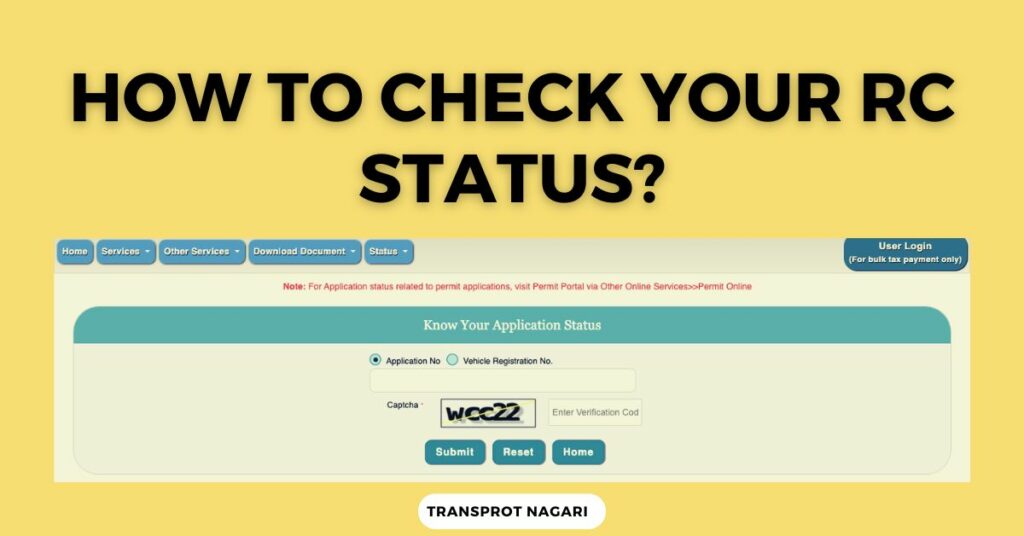RC Status: Online Process to Check Your Registration Certificate Application & Transfer Status
Are you a vehicle owner wondering about the current status of your Registration Certificate (RC)? Whether you want to know if your RC is valid or if there are any discrepancies in the details mentioned in it, checking your RC status is a crucial step to ensure that you are driving legally on the roads.

In this article, we will provide you with all the information you need to know about RC Status, including what it is, why it is important to check it, and how to check it online. So, let’s get started and ensure that your vehicle’s RC is up-to-date!
How to Check RC Status Online?
Knowing the RC status of your vehicle is important to ensure that you comply with the rules and regulations related to vehicle ownership and usage. In this section, we will guide you through the step-by-step process of checking your vehicle’s RC status on the Parivahan Sewa portal. Follow these steps to check RC status online:
- Go to the Parivahan Sewa portal at https://parivahan.gov.in/parivahan/.
- Click on “Informational Services” in the main menu.
- Select “Know your Vehicle Details” from the drop-down menu.
- You will be redirected to a login page. Enter your phone number.
- If you don’t have an account, create a new account using your phone number.
- Click on “next” and enter your account password.
- You will be redirected to a new page where you can enter your vehicle number.
- Enter your vehicle number to check your RC status.
- Enter the captcha code.
- Click on the “Vahan Search” button.
- You will be directed to the RC status page where you can check the status of your vehicle, such as whether it is active or expired.
How to Check RC Application Status Online?
If you have recently applied for any changes to your vehicle registration certificate, such as a transfer of ownership or a request for a duplicate RC, you can track the status of your application online using the Parivahan portal. This feature is especially useful for those who are eagerly waiting for their new RC or those who need to ensure that the transfer of ownership is completed successfully.
Follow the following steps for RC Status check by application number:
- Visit the Parivahan portal at https://parivahan.gov.in/parivahan/.
- Click on the “Online Services” tab, which will display a drop-down menu.
- From the drop-down menu, select the tab for “Vehicle Related Services”.
- Select your state from the list provided and navigate to a new page.
- On the new page, select your state and RTO from the options available and then click on the “Continue” button.
- On the next page, select the “Know Your Application Status” option from the various options presented.
- Enter your application number in the space provided.
- Click on the “Submit” button to view the current status of your application.
RC Status Particulars You Can Check Online
When you check your vehicle’s RC status on the Parivahan Sewa portal, you will be able to access a variety of important particulars related to your vehicle’s registration certificate. Here are the RC status particulars you can check online:
- Vehicle Category – This information provides details about the type of vehicle you own, such as a two-wheeler, four-wheeler, commercial vehicle, etc.
- Fuel Emission Stage – This tells you about the level of emissions your vehicle is based on, such as BS IV, BS VI, etc.
- RC Status – This indicates whether your vehicle’s registration certificate is currently active or expired.
- Owner Name – This provides the name of the registered owner of the vehicle.
- Registration Date – This indicates the date on which your vehicle was registered with the Regional Transport Office (RTO).
- Fitness Certificate Validity – This tells you about the validity period of your vehicle’s fitness certificate, which is important for ensuring that your vehicle is roadworthy.
- MV Tax Validity – This information provides details about the validity period of your vehicle’s motor vehicle tax payment.
- Insurance Validity – This tells you about the validity period of your vehicle’s insurance policy, which is important for ensuring that your vehicle is covered in case of any untoward incident.
- PUCC Validity – This provides details about the validity period of your vehicle’s Pollution Under Control Certificate (PUCC), which is important for ensuring that your vehicle meets the prescribed emissions standards.
- National Permit Details – This information is relevant for commercial vehicles and provides details about the national permit status of the vehicle.
- Finance Details (if applicable) – This provides details about any financing arrangement on your vehicle, such as a loan or lease, and its current status.